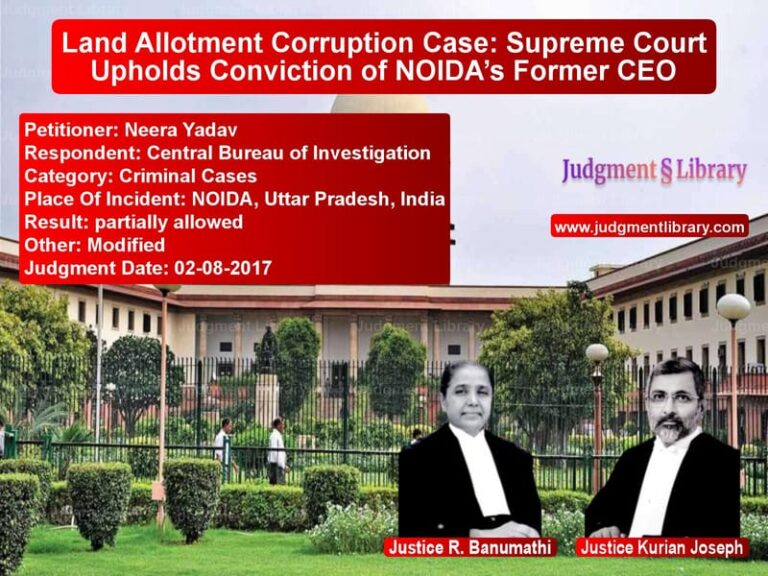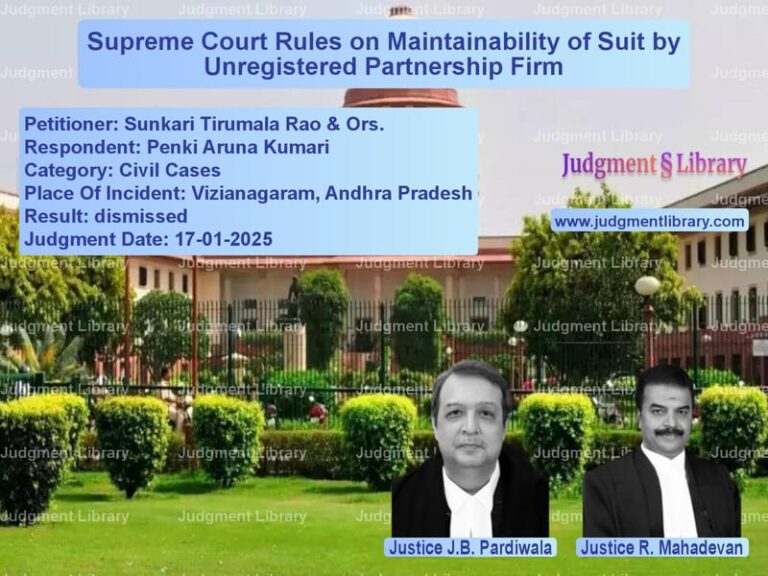Water Release and Property Damage: Supreme Court’s Judgment on Negligence and Compensation
The present case revolves around the release of water from the Mazum dam by the State of Gujarat, which caused substantial damage to the appellant’s agricultural land. The appellants, Vohra Sadikbhai Rajakbhai and others, claimed that the release of 60,000 cusecs of water, which flooded their fields and destroyed their hybrid berry plantation, was due to negligence on the part of the respondents. The respondents, on the other hand, contended that the release of water was a necessary action to prevent the breach of the dam caused by heavy rainfall, an act which they classified as an ‘act of God’. The issue primarily revolved around whether the damage was caused by negligence or was the result of an inevitable act of nature, and whether compensation was warranted under such circumstances.
Background of the Case
The appellants owned land adjacent to the Mazum Dam, where they cultivated hybrid berry trees. On June 6, 1997, Gujarat experienced heavy rains, which caused the water level in the Mazum Dam to rise significantly. In response to the threat of a breach, the respondents decided to release 60,000 cusecs of water from the dam to prevent a larger disaster. This release, however, flooded the appellant’s agricultural land, uprooting and damaging approximately 1500 trees, which were the source of the appellants’ livelihood. The appellants argued that the damage was not due to an act of God but rather the respondents’ failure to maintain the water levels in the dam adequately, given the anticipated monsoon rains.
The Petitioner’s Arguments
- The appellants contended that the damage was caused due to the respondents’ gross negligence in failing to properly manage the water levels in the dam before the rains.
- They argued that the respondents had failed to take adequate preventive measures, which led to the flooding of their land and destruction of crops, resulting in the loss of their livelihood.
- The appellants also contended that the respondents had violated their duty to maintain the water levels at a safe and appropriate level, given the forecasts of heavy rains.
- Further, the appellants stated that despite the release of the water being claimed as an ‘act of God’, it was, in fact, a foreseeable event, and the respondents were duty-bound to prepare for such contingencies.
The Respondent’s Arguments
- The respondents argued that the water release was necessary to prevent the breach of the dam, which could have caused widespread destruction in the region. They claimed that the release of water was done in the public interest.
- They stated that the excessive rainfall in the region was an ‘act of God’, and the release of the water from the dam was a necessary measure to safeguard the integrity of the dam and prevent a larger disaster.
- The respondents also emphasized that they had followed the standard operating procedures to release water based on the rising water levels in the dam, which were not predictable in magnitude.
- The respondents denied any negligence on their part, asserting that they had no other option but to release the water, as maintaining a low level of water in the dam would have posed a risk of dam failure.
Legal Issues and Court’s Observations
The Court needed to address two key legal issues:
- Whether the release of water by the respondents constituted negligence or if it was justified due to the heavy rainfall and resulting overflow of the dam, amounting to an ‘act of God’.
- If negligence was found, whether the appellants were entitled to compensation for the damages caused to their crops and livelihood.
Negligence and ‘Act of God’
The Court noted that while the excessive rainfall leading to the overflow of the dam could be considered an act of nature, the respondents’ failure to maintain an adequate level of water in the dam to account for such rains could not be overlooked. The appellants had pointed out that the respondents were aware of the impending rains and could have taken measures to release the water gradually, without causing the flood damage. The Court concluded that the release of water was, in part, due to the negligence of the respondents in failing to manage the water levels proactively.
Doctrine of Strict Liability
The Court also examined the applicability of the doctrine of strict liability, as outlined in the case of Rylands v. Fletcher, in which a person who brings something onto their land that is likely to cause harm if it escapes is liable for the damage caused. The Court found that the respondents, who had control over the dam, were strictly liable for the damage caused by the release of water, especially considering their failure to manage the situation adequately.
Quantum of Compensation
While the appellants failed to provide precise evidence of the damages, the Court noted that the loss of livelihood due to the destruction of crops was evident. The Court acknowledged the report submitted by the Court-appointed commissioners, which confirmed the uprooting of 1500 trees, and the photographs attached to the report supported the claim of damage. The Court, however, agreed that the appellants could not claim the exact value of the lost trees but awarded a reasonable sum as compensation based on the available evidence. The Court decided that the appellants were entitled to ₹5,00,000 as compensation, considering the loss of livelihood, though the exact amount could not be precisely determined due to the lack of documentary evidence supporting the claim for damages.
Supreme Court’s Judgment
The Supreme Court, after analyzing the arguments and evidence, ruled in favor of the appellants, holding that the respondents’ failure to maintain adequate water levels in the dam amounted to negligence. The Court noted that while the release of water was necessary to prevent a dam breach, the respondents had not taken sufficient precautionary measures to manage the water levels adequately before the monsoon season. As a result, the Court ordered compensation of ₹5,00,000 for the damage caused to the appellants’ land and crops. The Court also directed the respondents to pay interest on the awarded compensation from the date of the trial court’s judgment.
Conclusion
This case highlights the importance of maintaining proper management practices for infrastructure projects like dams, especially when they have the potential to cause harm to nearby properties. The judgment reaffirms the principle of negligence in the context of public infrastructure and emphasizes the duty of authorities to prevent foreseeable damage. The Court’s decision ensures that the rights of the landowners are protected, and the negligence of state or private entities cannot be excused due to unforeseen events. The case serves as a reminder of the duty of care owed by authorities managing public infrastructure to nearby citizens.
Don’t miss out on the full details! Download the complete judgment in PDF format below and gain valuable insights instantly!
Download Judgment: Vohra Sadikbhai Raja vs State of Gujarat & O Supreme Court of India Judgment Dated 10-05-2016-1741860841054.pdf
Direct Downlaod Judgment: Direct downlaod this Judgment
See all petitions in Property Disputes
See all petitions in Damages and Compensation
See all petitions in Environmental Cases
See all petitions in Judgment by A.K. Sikri
See all petitions in Judgment by R K Agrawal
See all petitions in allowed
See all petitions in supreme court of India judgments May 2016
See all petitions in 2016 judgments
See all posts in Civil Cases Category
See all allowed petitions in Civil Cases Category
See all Dismissed petitions in Civil Cases Category
See all partially allowed petitions in Civil Cases Category







